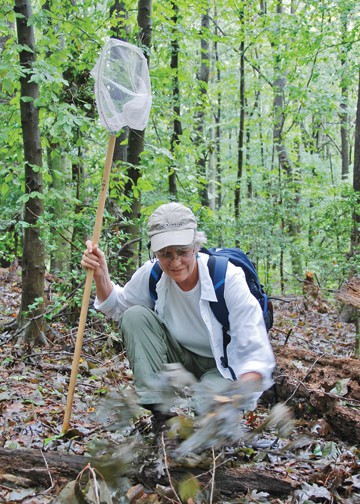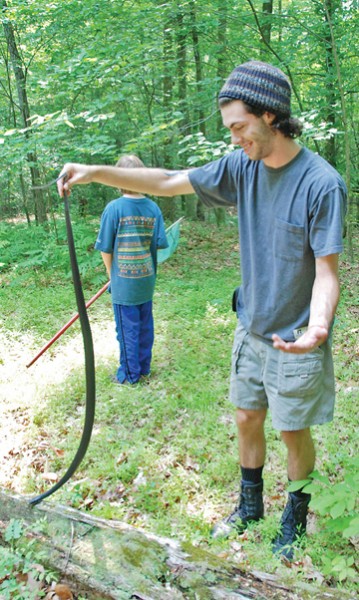Hunting Herptiles
“Why am I always stuck in the mud?” asked five-year-old Xavier Dailey. Xavier was one of the youngest in the group of rummaging herptile hunters on the annual pilgrimage, this year to Kings Landing Park in Calvert County in search of amphibians and reptiles.
When Xavier wasn’t mucking through the creek, he was exploring rotten logs and hunting herps with gusto in a search organized by Andy Brown, Calvert County Department of Natural Resources naturalist. It’s a local contribution to the Maryland Amphibian and Reptile Atlas, a map of the territories of our resident herptiles — the ones still here. The survey runs through 2014. Herp hunters will help fill out the Atlas and describe the state of the ecosystem.
| Herptiles, like the American toad and the Eastern box turtle, are “our bio-indicator,” says naturalist Andy Brown. He is overseeing Calvert County’s count for the Maryland Amphibian and Reptile Atlas. |
The moist skin of amphibians makes them sensitive to chemical changes. “They’re our bio-indicator,” Brown says. “Poor water quality will impact them and impact us.
“You hear what the places used to look like,” he continues, repeating a familiar lecture he’d rather not give. “It’s very different today. You hate to see the loss of diversity because it means our environmental quality is declining.”
For that reason, as you hunt, you put things back the way you find them. “You don’t want to destroy habitat,” explains dedicated hunter Mary Hollinger, a biologist retired from the National Oceanic and Atmospheric Administration.
The Hunt
Armed with nets on long poles, Xavier’s hunting party sought the survivors. Box turtles hide under branches and leaves to look for earthworms. Salamanders and snakes live under logs.
“My net is my best friend,” Hollinger says. “I use my dip stick for heavy logs or getting things that are hopping away from me. I also use it to pin a snake down and pick it up by the neck.”
Snakes?
 |
“The time I spend dispelling myths,” sighs Brown.
“Copperheads are not deadly,” he explains. “But a bite is painful and can cause tissue damage.”
Snake conversation animates Hollinger. “On Brownie’s Beach they insisted there was a water moccasin,” she reports, disdainfully. She says there are no water moccasins above Virginia’s Great Dismal Swamp. We have two water snakes: the northern water snake and the northern red-bellied snake.
Nonetheless, Hollinger wears gloves to hunt herps.
Box turtles, which don’t give people the creeps, “are the canary in the coal mine,” Brown says. “From five years ago, their number is down. They’re getting killed on the road. It’s a loss of quality where we live.”
The Hunters
Many of the hunters are amateurs who’ll learn as they go. Others are pros.
Hollinger, who grew up in St. Mary’s County and spent summers picking around tidal ponds, is a pro. “Single-handedly, she checked off all of the frog species for more than 20 of Calvert’s 39 blocks,” Brown says.
For the Atlas survey, Maryland is divided into quadrants of six blocks each. Each block covers 10 square miles.
Hollinger has learned to distinguish frog calls and records their voices to send to Brown along with their locations. She cruises at night, driving slowly and watching shoulders for night-roving herps.
“Police seem bemused by a middle-of-the-night, gray-haired herp hunter,” she reports. So she printed a Data Collection sign for the front window of her car.
Her night watches are rewarding. Driving through Prince Frederick, she shouted, That’s it! She’d heard a missing frog.
Hollinger’s expertise is not limited to frogs.
“We expected that it would be spotty to find a red salamander. Mary’s gotten one from Huntingtown,” Brown reports.
 |
On the hunt for the red salamander, Kevin Foley, a 2008 graduate of Patuxent High School, is beating Hollinger. He found two in the Cove Point Quad.
“He’s just crazy about reptiles and amphibians,” says Brown, who spoke to an Advanced Placement environmental science class where Foley was a student. “He spends a lot of time in the field chasing his passion. He spent his birthday in the mountains of North Carolina looking for hellbenders,” giant salamanders.
Foley’s quest to see as many species as he can has earned him bites as well as rewards.
A male black racer snake warming in the sun heard the hunters and ducked under a log. Foley eventually caught it, grabbing and dangling it by the tail.
Then he let the snake escape back under the log.
Making History
The Atlas will be the first observation-based catalog of herptiles in Maryland. “The last distributional survey was in 1975, based on museum specimens in jars, hit or miss, not cataloged, not documented,” Brown says.
 |
Until the next organized Calvert County hunt in spring 2013, Brown is encouraging citizens to keep looking and sending him photographs and frog recordings. “The hunting is definitely ongoing,” he says, “and we’d love for folks to keep reporting their sightings.”
For herp finds and questions in Calvert County, contact Andy Brown: 410-535-5327; [email protected]. In Anne Arundel County, a variety of sanctuaries, parks and natural history organizations sponsor herptile hunts: Dave Walbeck: 410-537-3831; [email protected].
Join the hunt at Jug Bay Wetlands Sanctuary Saturday, May 12, 1-3pm.
